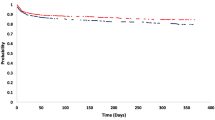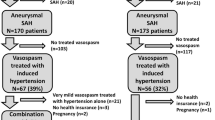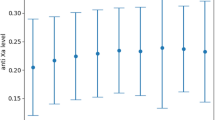Abstract
Objective
Data regarding diagnosis, management, and prognosis of patients with cerebral venous thrombosis (CVT) from high altitude are limited. The aim of the present study is to identify the clinical features, risk factors, and outcomes of cerebral venous thrombosis (CVT) in Tibet.
Methods
We retrospectively included patients with a diagnosis of CVT consecutively admitted to Tibet Autonomous Region People’s Hospital between July 2015, and September 2022. The risk factors, clinical and radiological presentations, treatment and outcomes were analyzed.
Results
A total of 38 patients with CVT were included in this study. The median age was 31 years, and females accounted for 63.2%. Patients of Tibetan nationality accounted for 71.1% (n = 27) and the median altitude of residence in Tibet was 3800 m (3657, 4054). Headache was the most common symptom (92.1%). The most common risk factors of CVT were infection in the past 4 weeks (34.2%) and pregnancy or puerperium (23.7%). Lateral sinus (transverse and/or sigmoid sinus) (68.4%) and superior sagittal sinus (55.3%) were the most commonly involved. The D-dimer increased in 31 patients (81.6%). All three patients who died in hospital and during follow-up had risk factor of recent infection. Favorable outcome at follow-up with a median length of 454 days (189, 1059) was observed in 85.3% of patients.
Conclusions
CVT at high altitude is more common in young patients and women, with various clinical manifestations and risk factors. Recent infection is the most common risk factor and may increase the mortality of CVT at high altitude. The long-term prognosis of CVT at high altitude is favorable.

Similar content being viewed by others
Data availability
The datasets generated and analyzed during the current study are available from the corresponding authors on reasonable request.
References
Ropper AH, Klein JP (2021) Cerebral venous thrombosis. N Engl J Med 385:59–64. https://doi.org/10.1056/NEJMra2106545
Tatlisumak T, Jood K, Putaala J (2016) Cerebral venous thrombosis: epidemiology in change. Stroke 47:2169–2170. https://doi.org/10.1161/strokeaha.116.014336
Fang J, Zhuo-Ga C, Zhao Y, Kong F, Si Y, Liu M et al (2011) Characteristics of stroke in tibet autonomous region in China: a hospital-based study of acute stroke. Eur Neurol 66:151–158. https://doi.org/10.1159/000330558
Lu Y, Zhuoga C, Jin H, Zhu F, Zhao Y, Ding Z et al (2020) Characteristics of acute ischemic stroke in hospitalized patients in Tibet: a retrospective comparative study. BMC Neurol 20:380. https://doi.org/10.1186/s12883-020-01957-0
Hassan WU, Syed MJ, Alamgir W, Awan S, Bell SM, Majid A et al (2019) Cerebral venous thrombosis at high altitude: analysis of 28 cases. Cerebrovasc Dis 48:184–192. https://doi.org/10.1159/000504504
Li M, Tang X, Liao Z, Shen C, Cheng R, Fang M et al (2022) Hypoxia and low temperature up-regulate transferrin to induce hypercoagulability at high altitude. Blood. https://doi.org/10.1182/blood.2022016410
Prabhakar A, Chatterjee T, Bajaj N, Tyagi T, Sahu A, Gupta N et al (2019) Venous thrombosis at altitude presents with distinct biochemical profiles: a comparative study from the Himalayas to the plains. Blood Adv 3:3713–3723. https://doi.org/10.1182/bloodadvances.2018024554
Wu J, Han X, Ke H, Wang L, Wang K, Zhang J et al (2022) Pulmonary embolism at extreme high altitude: a study of seven cases. High Alt Med Biol 23:209–214. https://doi.org/10.1089/ham.2021.0109
Saposnik G, Barinagarrementeria F, Brown RD Jr, Bushnell CD, Cucchiara B, Cushman M et al (2011) Diagnosis and management of cerebral venous thrombosis: a statement for healthcare professionals from the American Heart Association/American Stroke Association. Stroke 42:1158–1192. https://doi.org/10.1161/STR.0b013e31820a8364
Khattar NK, Sumardi F, Zemmar A, Liang Q, Li H, Xing Y et al (2019) Cerebral venous thrombosis at high altitude: a retrospective cohort of twenty-one consecutive patients. Cureus 11:e4940. https://doi.org/10.7759/cureus.4940
Wasay M, Kaul S, Menon B, Dai AI, Saadatnia M, Malik A et al (2019) Asian study of cerebral venous thrombosis. J Stroke Cerebrovasc Dis 28:104247. https://doi.org/10.1016/j.jstrokecerebrovasdis.2019.06.005
Ding J, Song B, Xie X, Li X, Chen Z, Wang Z et al (2022) Inflammation in cerebral venous thrombosis. Front Immunol 13:833490. https://doi.org/10.3389/fimmu.2022.833490
Jain RS, Sripadma PV, Tejwani S (2022) Clinical characteristics, etiology, recanalization rates and neurological outcomes in CVT: a prospective cohort study. Ann Indian Acad Neurol 25:229–234. https://doi.org/10.4103/aian.aian_718_21
Acknowledgements
The authors would like to thank all patients for participating in the project and all the staff for the time and effort they devoted.
Funding
This study was supported by grants from STI2030-Major Project #2021ZD0201100 Task 5 #2021ZD0201105 and National High Level Hospital Clinical Research Funding (2022-PUMCH-D-007).
Author information
Authors and Affiliations
Contributions
JN, LZ contributed to study concept and design. YC, YS, ZC, YZ made contributions to data collection and analysis. YS contributed to manuscript drafting. Critical revision of the manuscript for intellectual content was completed by JN and LZ.
Corresponding authors
Ethics declarations
Conflicts of interest
The authors declare that the research was conducted in the absence of any potential conflict of interest.
Ethical approval
The study followed the Strengthening the Reporting of Observational Studies in Epidemiology reporting guidelines. This study was approved by the ethical review board of Tibet Autonomous Region People’s Hospital.
Consent for publication
All authors agreed to the submission.
Additional information
Yuhui Sha and Yang Ci are co-first authors.
Rights and permissions
Springer Nature or its licensor (e.g. a society or other partner) holds exclusive rights to this article under a publishing agreement with the author(s) or other rightsholder(s); author self-archiving of the accepted manuscript version of this article is solely governed by the terms of such publishing agreement and applicable law.
About this article
Cite this article
Sha, Y., Ci, Y., Cidan, Z. et al. Clinical and prognostic characteristics of cerebral venous thrombosis at high altitude: a single-center retrospective study of Tibet. J Neurol 270, 2688–2692 (2023). https://doi.org/10.1007/s00415-023-11597-2
Received:
Revised:
Accepted:
Published:
Issue Date:
DOI: https://doi.org/10.1007/s00415-023-11597-2




